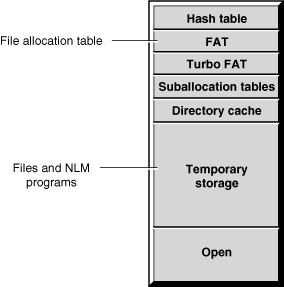
NetWare 6 requires a minimum of 256 MB of RAM and can access up to 64 GB of RAM. After the SERVER.EXE file is loaded, all remaining memory is assigned to cache memory and Virtual memory, which is available for NetWare Loadable ModuleTM (NLMTM) programs and other processes to use. The memory allocator will only allocate up to 4 GB of memory to cache memory and the remaining will be using by the virtual memory system. When data is stored in cache, it is stored in 4 KB blocks called cache buffers.
Recently used data is kept in cache buffers in case it is needed again. Caching data speeds processing because data can be written to or read from cache hundreds of times faster than it can be read from or written to disk.
Cache memory is used for all the server's processing needs, such as the following:
Memory from cache is allocated to an NLM program when requested. When an NLM program is finished using the memory, it releases the memory and returns it to cache. NetWare also provides a garbage collection process to recover unused memory. The garbage collector runs in the background, but you can manually initiate the process if needed. See Optimizing Garbage Collection.
There are two kinds of cache: directory cache and file cache.
Directory cache is used only with the traditional NetWare file system, not with the Novell® Storage ServicesTM (NSS) file system. Directory cache stores disk directory entries. When the server is first installed, NetWare allocates 20 directory cache buffers of 4 KB each. If more buffers are needed, NetWare tunes the server by increasing the number of directory cache buffers. You can also tune the number of directory cache buffers yourself, using two server parameters that establish the minimum and maximum number of directory cache buffers the server can allocate. For information about tuning directory cache, see Tuning Directory Cache for the Traditional File System.
File cache is used with both the traditional file system and the NSS file system. File cache is a pool of 4 KB memory pages. File cache stores recently used file data and also parts of the Novell eDirectoryTM database.
In an ideal environment, there is enough memory so that all frequently used data can be retrieved from file cache rather than from disk.
Monitoring the disk cache utilization statistic can help you estimate whether your server has sufficient memory to service requests from cache. For information about optimizing file cache, see Tuning File Cache.